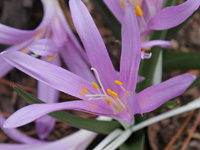![]()
Spring Meadow Saffron (Bulbocodium vernum) is a species of alpine bulb that thrives in mountainous regions across Europe, stretching from the Pyrenees to the Caucasus. Its natural range includes countries such as Spain, France, Italy, Switzerland, Austria, Hungary, Romania, and parts of the former Yugoslavia, Ukraine, and southern European Russia. Adapted to high-altitude environments, this hardy perennial bulb is well-suited to the cool, rocky landscapes where it naturally occurs.
Beyond its native habitat, Spring Meadow Saffron is widely cultivated as an ornamental plant, prized for its early spring blooms and vibrant color. It is particularly well-regarded for its suitability in rock gardens, where its delicate flowers create a striking contrast against stones and alpine settings. Additionally, when planted in clusters or groups, the flowers produce a visually stunning display, making them a popular choice for garden borders, meadows, and naturalized landscapes. Their ability to thrive in well-drained soils and withstand cold temperatures further enhances their appeal for gardeners looking to add a touch of early-season beauty to their outdoor spaces. With its graceful blooms and adaptability, Spring Meadow Saffron remains a cherished addition to cultivated gardens as well as wild alpine meadows.
![]()
Spring Meadow Saffron is commerically used as an ornamental plant.
![]()
Within the realm of rational and holistic medicine, there is currently no known use for spring meadow saffron.
Please note that MIROFOSS does not suggest in any way that plants should be used in place of proper medical and psychological care. This information is provided here as a reference only.
![]()
Spring Meadow Saffron is considered to be a toxic plant and there is currently no known edible properties for this species.
Please note that MIROFOSS can not take any responsibility for any adverse effects from the consumption of plant species which are found in the wild. This information is provided here as a reference only.
![]()
Spring Meadow Saffron (Bulbocodium vernum) thrives in sunny locations, where it can receive ample light to support its growth and early-season blooms. It is commonly found growing along slopes in its native alpine regions, taking advantage of well-drained conditions that prevent excess moisture from accumulating around its roots. When cultivated, it is well-suited for garden beds and rock gardens, where it can be planted in clusters to create a striking floral display. The plant prefers medium-textured, loamy soil, which provides a balance of moisture retention and drainage, ensuring healthy growth. Additionally, Spring Meadow Saffron favors slightly acidic soil conditions, which closely mimic the natural environments where it flourishes.
One of the notable characteristics of Spring Meadow Saffron is its toxicity, which makes it unpalatable to herbivores such as deer. Unlike many other garden plants that can be damaged by browsing animals, this species remains largely undisturbed, allowing it to thrive in areas where deer populations are high. While its toxicity serves as a natural defense mechanism against herbivory, gardeners should exercise caution when handling the plant, as it can be harmful if ingested by humans or pets. Despite this, its striking flowers and resilience in various growing conditions make it a desirable addition to ornamental gardens, particularly in areas where deer-resistant plants are needed.
| Soil Conditions | |
| Soil Moisture | |
| Sunlight | |
| Notes: |
![]()
Spring Meadow Saffron (Bulbocodium vernum) is a hardy perennial plant that typically grows up to 10 centimeters in height, making it a compact yet striking addition to alpine and rock gardens. During its blooming season, which lasts from April to June, the plant produces strap-shaped leaves that emerge alongside its delicate, crocus-like flowers. These blooms range in color from soft pink to deep purple and measure between 3 and 8 centimeters in diameter, creating a vibrant display that stands out in early spring landscapes.
Like all members of the Colchicum genus, Spring Meadow Saffron is highly toxic due to the presence of colchicine, a potent alkaloid. This toxicity serves as a natural deterrent to herbivores, ensuring that the plant remains undisturbed by deer and other grazing animals. However, its poisonous nature means that it should be handled with care, as ingestion can be harmful to both humans and pets. Despite its toxicity, Bulbocodium vernum remains a popular choice for ornamental cultivation, valued for its resilience, early-season blooms, and ability to thrive in well-drained soils in both natural and cultivated settings. Its bright flowers and compact growth make it a beautiful, low-maintenance addition to gardens, particularly in areas where deer-resistant plants are needed.
![]()
| Plant Height | 10cm |  |
| Habitat | Cultivated areas, sloped areas | |
| Leaves | Subulate | |
| Leaf Margin | Entire | |
| Leaf Venation | Parallel | |
| Stems | Smooth stems | |
| Flowering Season | March to May | |
| Flower Type | Bilaterally Symmetrical | |
| Flower Colour | Pink | |
| Pollination | Various Insects | |
| Flower Gender | Flowers are hermaphrodite and the plants are self-fertile | |
| Fruit | Corms | |
| USDA Zone | 5A (-26°C to -28°C) cold weather limit |
![]()
The following health hazards should be noted when handling or choosing a location to spring meadow saffron:
 |
TOXICITY spring meadow saffron, along with other species in colchicum family, are toxic if ingested. |
![]()
Spring Meadow Saffron is not known under any other common names.

![]()
 |
What's this? What can I do with it? |
![]()
| Dickinson, T.; Metsger, D.; Bull, J.; & Dickinson, R. (2004) ROM Field Guide to Wildflowers of Ontario, Royal Ontario Museum, Toronto:McClelland and Stewart Ltd. | |
| Hanelt, Peter; Büttner, R.; Mansfeld, Rudolf; Kilian, Ruth (2001), Mansfeld's Encyclopedia of Agricultural and Horticultural Crops, Springer, p. 2414, ISBN 3-540-41017-1 | |
| Invasive Plants of Asian Origin Established in the United States and Their Natural Enemies, Volume 1, USDA Forest Service, retrieved 2018-12-10 | |
| USDA-NRCS PLANTS Database / USDA NRCS. Wetland flora: Field office illustrated guide to plant species. USDA Natural Resources Conservation Service. | |
| National Audubon Society. Field Guide To Wildflowers (Eastern Region): Alfred A. Knopf. ISBN 0-375-40232-2 | |
| February 23, 2025 | The last time this page was updated |
| ©2025 MIROFOSS™ Foundation | |
 |
|









